Today’s entry marks Helix day (http://www.thehelix.co.uk/) which is, coincidentally, today. The Helix is a development of the area where the Forth and Clyde Canal meets the River Carron. The Forth and Clyde Canal was constructed in the late 1700s to connect the Firth of Forth with the Firth of Clyde across the narrowest part of the Scottish lowlands, a distance of about 35 miles. The canal fell into disuse in the 1960s but has been spruced up for recreational use. A towpath was built alongside the canal for the use of horses towing canal boats. The eastern end of the canal near Grangemouth has been built over and the canal now connects to the Forth via a short segment of the River Carron. It is this area that is being developed as the Helix. One of the most impressive parts of the Helix is the Kelpies, 2 giant sculptures of horses’ heads, representing kelpies, supernatural water horses from Scottish mythology. They are 30 metres tall and weigh over 300 tonnes. I traveled past them a few days ago and they are very striking.
The reason I am talking about the Helix and the Canal is that Kathy and I just returned from a holiday in Scotland. While we were there we cycled the Forth and Clyde towpath, in effect cycling from one side of Scotland to the other. I have to confess two things however. Because it is the narrowest part of the country and because the builders used the Firths, it is a relatively short distance for a ‘coast to coast’ journey. (Much shorter than the 3,000+ miles across Canada) Also, we cheated a bit. We did not go as far as the Kelpies. Taking some advice from friends along the route we went as far as the Falkirk Wheel then changed course to follow the Union canal to Falkirk High rail station. The distance is a bit less, but it avoided a few miles of doubling back on the return as well as a segment which is apparently less navigable and less interesting. Our journey from Bowling Basin where the canal enters the Firth of Clyde to Falkirk High station ran for 56.7 km (35.2 mi).
To start our journey we rented bicycles and helmets from Cycle Scotland on Blackfriars Street in Edinburgh (http://cyclescotland.co.uk/) . The next morning, bright and early we headed for Waverley Train Station and had our first adventure: taking the bikes on a train. Luckily we had no trouble. We got on the train to Glasgow and found a car with a bike rack. One thing I love about Europe is the train service and it is so great that it is convenient to combine bicycle and rail travel. Unfortunately from Glasgow to Bowling we didn’t have a bike rack and had to manoeuvre our bikes to keep out of the way of our fellow travellers, but this wasn’t too bad and soon we were at the western end of the canal and ready to go.
Because the path runs along a canal, it is very level with only mild hills at the canal locks. The path is well maintained with a smooth surface and in most places is wide enough to ride side by side. The countryside was lovely with trees, fields and only the occasional built up area in sight. There were thistles and other wildflowers along the canal and swans and ducks in the water, as well as a few canal boats.
We passed by several small towns and there were a number of pubs and restaurants on or near the path. Our first stop was at the Clydebank shopping centre which is right on the canal. We had a snack at McDonalds (local restaurant, not the golden arches. Another thing I love about Scotland) Then it was off again on our bikes.
We carried on as far as Kirkintilloch where we had arranged to meet Findlay Brown who lives right beside the canal. Findlay is the secretary of the Kilsyth Curling Club which is the world’s oldest curling club, founded in 1716. In just 3 years they will be 300 years old! I found Findlay while looking for information about the club, as I have been a curler in the past and also some of my ancestors came from Kilsyth and Kirkintilloch.
Findlay and his wife Kathryn were very friendly and after a visit at their home and a drink we exchanged curling pins. Later, even though they were busy preparing for their daughter’s wedding, they showed us around the area, including the world’s oldest curling pond on the Colzium Estate and then they took us out for supper. Despite any stereotypes, my experience with the Scots is that they tend to be very generous people.
Because the path of the canal is the narrowest route across the country it is also the path chosen by the Romans to build the Antonine Wall (http://www.antoninewall.org/) , the lesser known second wall, north of the more famous Hadrian’s Wall. The wall and its forts were built in the AD 140s. We visited the site of one of the forts along the Antonine Wall, Bar Hill Fort where we saw the remains of the headquarters, barracks and bath house.
Due to a mix up at our B and B we ended staying at Dyke Farm with Kathryn’s sister and brother-in-law, Sheila and Jimmy MacGregor. Jimmy is the president of the Kilsyth curling club and breeds champion black-faced sheep.
The next day we completed our journey. We stopped at Bonnybridge for a pub lunch at the Bridge Inn
and then visited the Falkirk Wheel (http://www.falkirk-wheel.com/) which is an engineering marvel.
After a visit at the wheel and a stop at the gift shop, we headed off along the union canal. If we were more ambitious we could have continued all the way to Lochrin Basin, 2 miles from our flat in Edinburgh, but we were looking forward too much to sitting on something more comfortable than a bicycle seat and elected to catch the train at Falkirk High back to Waverley.
Once again we were lucky enough to get a car with a bike rack and we soon had the bikes back at Cycle Scotland.

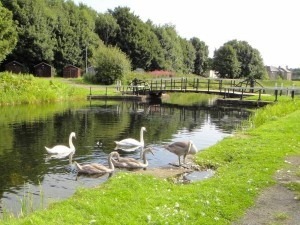

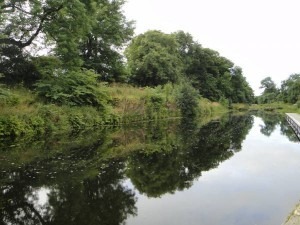
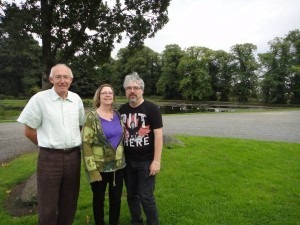
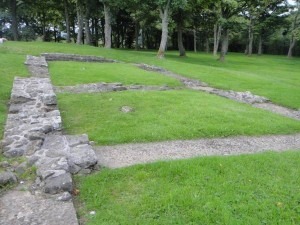
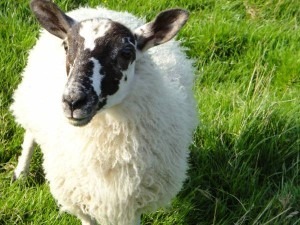

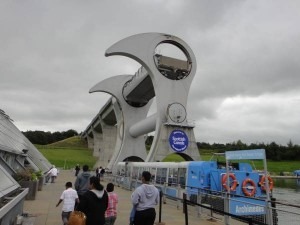

Oh my gosh that little sheep is so cute. That’s a great picture.
I desire to see the kelpies!